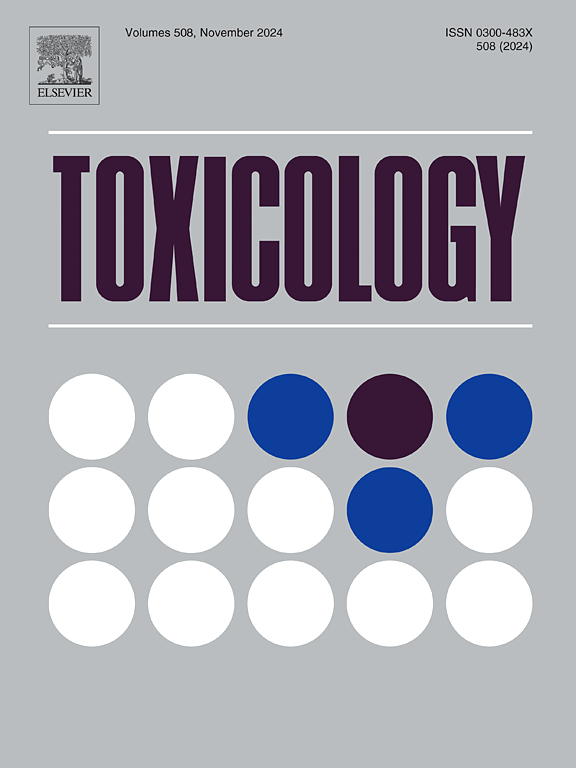2-Ethylhexyl-2,3,4,5-tetrabromobenzoate (TBB) triggers Z-DNA-binding protein 1(ZBP1)- (Receptor-interacting serine/threonine-protein kinase 3) RIP3 mediated programmed necrosis in hepatic cells by inducing mitochondrial left-handed helix (Z-DNA) release
IF 4.6
3区 医学
Q1 PHARMACOLOGY & PHARMACY
引用次数: 0
Abstract
Traditional Polybrominated Diphenyl Ethers (PBDEs) have been gradually banned due to their significant health impacts. As a substitute, the novel brominated flame retardant 2-ethylhexyl-2,3,4,5-tetrabromobenzoate (TBB) has been extensively utilized in industrial and consumer products. TBB has been detected in various environmental media, organisms, and humans, suggesting potential health risks. However, existing toxicological studies on TBB are still limited. The liver is one of the most important target organs in toxicological research. Therefore, we explored the toxicological effects of TBB on liver. Therefore, a series of corresponding biochemical experiments were conducted to evaluate the toxicological effects of TBB. Firstly, CCK8 and EdU assays indicated that TBB blocked the proliferation of hepatocytes. Cell cycle analysis demonstrated that TBB inhibited cell cycle progression; Secondly, TBB treatment causes mitochondrial damage by detection of mitochondrial membrane potential. Further work found that TBB led to programmed necrosis, which is mediated by ZBP1. Mechanistically, we found that TBB induced mitochondrial damage, as evidenced by impaired mitochondrial membrane potential, followed by mitochondrial genome instability and subsequent generation/release of mitochondrial Z-DNA, which subsequently drives both cell death and inflammatory responses. In conclusion, this study investigated the toxicological effects of the novel brominated flame retardant (TBB), these findings indicate that limiting TBB usage should be prioritized in future studies.
2-乙基己基-2,3,4,5-四溴苯甲酸酯(TBB)通过诱导线粒体左旋螺旋(Z-DNA)释放触发Z-DNA结合蛋白1(ZBP1)-(受体相互作用丝氨酸/苏氨酸蛋白激酶3)RIP3介导的肝细胞程序性坏死。
传统的多溴联苯醚(PBDEs)由于其对健康的重大影响而逐渐被禁止。作为一种新型溴化阻燃剂,2-乙基己基-2,3,4,5-四溴苯甲酸酯(TBB)在工业和消费品中得到了广泛应用。TBB已在各种环境介质、生物体和人类中被检测到,表明存在潜在的健康风险。然而,现有的TBB毒理学研究仍然有限。肝脏是毒理学研究中最重要的靶器官之一。因此,我们探讨了TBB对肝脏的毒理学影响。因此,我们进行了一系列相应的生化实验来评价TBB的毒理学效应。首先,CCK8和EdU实验表明,TBB可以阻断肝细胞的增殖。细胞周期分析表明,TBB抑制细胞周期进程;其次,TBB治疗通过检测线粒体膜电位引起线粒体损伤。进一步的研究发现TBB导致程序性坏死,这是由ZBP1介导的。在机制上,我们发现TBB诱导线粒体损伤,线粒体膜电位受损,随后线粒体基因组不稳定和线粒体Z-DNA的产生/释放,随后导致细胞死亡和炎症反应。综上所述,本研究对新型溴化阻燃剂(TBB)的毒理学效应进行了研究,结果表明限制TBB的使用应是今后研究的重点。
本文章由计算机程序翻译,如有差异,请以英文原文为准。
求助全文
约1分钟内获得全文
求助全文
来源期刊

Toxicology
医学-毒理学
CiteScore
7.80
自引率
4.40%
发文量
222
审稿时长
23 days
期刊介绍:
Toxicology is an international, peer-reviewed journal that publishes only the highest quality original scientific research and critical reviews describing hypothesis-based investigations into mechanisms of toxicity associated with exposures to xenobiotic chemicals, particularly as it relates to human health. In this respect "mechanisms" is defined on both the macro (e.g. physiological, biological, kinetic, species, sex, etc.) and molecular (genomic, transcriptomic, metabolic, etc.) scale. Emphasis is placed on findings that identify novel hazards and that can be extrapolated to exposures and mechanisms that are relevant to estimating human risk. Toxicology also publishes brief communications, personal commentaries and opinion articles, as well as concise expert reviews on contemporary topics. All research and review articles published in Toxicology are subject to rigorous peer review. Authors are asked to contact the Editor-in-Chief prior to submitting review articles or commentaries for consideration for publication in Toxicology.
 求助内容:
求助内容: 应助结果提醒方式:
应助结果提醒方式:


